
Gillian Pederson-Krag, Still Life, Oil on Canvas, 15” x 17”, 2007 Collection: P.L. Porter
click here for a larger view
Interview with Gillian Pederson-Krag by Elana Hagler
I’ve been aware of Gillian Pederson-Krag’s work for a number of years, but finding good images of her paintings and etchings online was very difficult, which is why I was especially excited to discover the new monograph of her work covering the years 1970 -2011. The book not only includes great reproductions of her evocatively colored and enigmatically composed landscapes, interiors and still-lifes, but also includes a group of her essays, collectively titled “Reflections on Painting.” I found her writing, touching on the subjects of “why we paint,” “what we paint,” drawing, color, unity and the purpose of art, as compelling as the images of her work. I hope that this interview can help elaborate on her insights as well as introduce new people to work that I have found and continue to find so inspiring.
Elana Hagler: Whereas I read your landscapes and still-lifes as primarily visual, formal delights, many of your figure compositions seem to have more invention to them and also a very strong mythical, archetypical component to them. Could you speak to the different roles that these genres fulfill for you?
Gillian Pederson-Krag Still-life and Landscape paintings seem to originate from what I am observing. The figure paintings appear to come from some kind of imaginative concept, but if I look closely, they all seem to spring from feelings I carry around with me.
It has struck me often that when I go out to paint the landscape, I always have the idea that I will be finding something new, that I will be surprised. And certainly there is an element of surprise in the nature, but it is far more the case that I recognize what I want to paint because it is akin to something that I feel and already know in some way. It is as though I am projecting onto the nature as much as I am perceiving it—remembering it as much as looking at it for the first time. This is even more the case with still-life objects. I start with observation, but I already have an idea even before I arrange the objects I am looking at. And the objects are old friends, as I generally paint the same cast of characters over and over again.
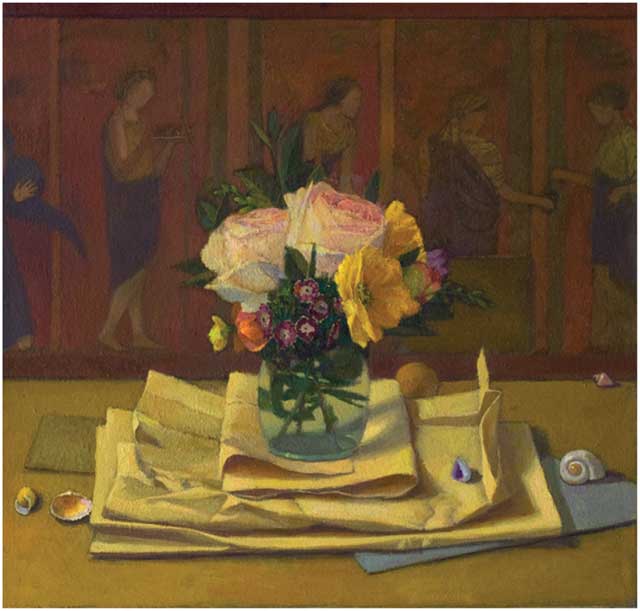
Still Life, Oil on Canvas, 18” x 17” 2007 Collection: Michael and Harriet Eisman, Lodi, NY
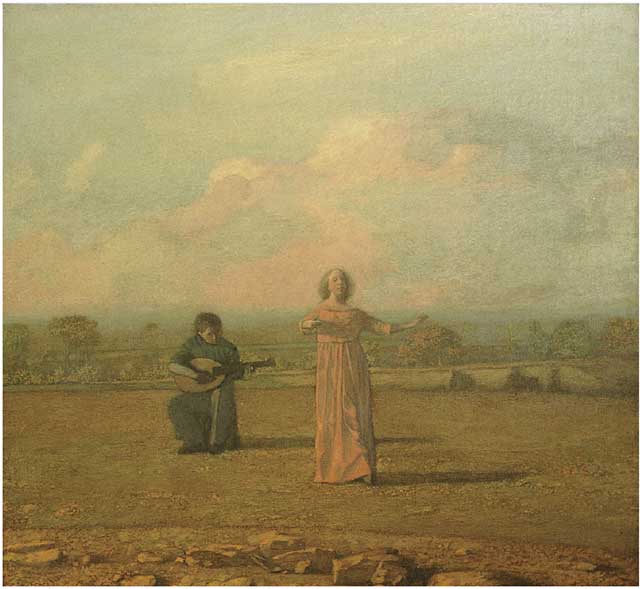
Two Performers, Oil on Canvas, 22” x 24”, 1981 Innes Collection, Charlottesville, VA
The figure paintings begin in an entirely different way. They are projects that require a lot of research, and I rarely if ever start from observation. They are all from secondary sources; drawings, memory, photos, imagination. All these sources have different kinds of realities, but in spite of this, it is possible to unify the painting because in the end, they all have to serve the image that is in my mind’s eye.
So these two kinds of painting start from different places, but as time has gone by, I feel less and less of a distinction between my perception of the outside world and the more transient images of my imaginative inner world. It all seems to be made of the same mysterious stuff.
EH:
Your work has a striking sense of unity to it. In your essay on unity, you write:
“What makes a painting meaningful is the spectacle of the ordinary content living together with the equally important life of the picture plane and the unity of the whole surface. I actually think that this phenomenon is attractive and satisfying because it reflects a feeling that we all have a kind of nostalgia for – the notion that life is somehow meaningful and that while we are indeed separate, we continually seek out ways of discovering situations which will allow us to feel part of a larger whole.”
Pg. 24
You point to “teachers of non-duality” such as Joseph Campbell and Francis Lucille as being very influential. How do you feel that reading has influenced your painting? And do you feel that the act of painting over time has given you insights into the world, human nature and spirituality?
GPK: My study of non-duality has had a profound effect on my life in general and given me a source of self-acceptance, an alternative to approaching life with a sense of competition, and has been a real source of inspiration. So in this sense, it has made me more available to painting, just as it has made me more available to life in general. But what has been very interesting to me is to discover that my experience in the studio has allowed me to come to some understanding of the principles of non-duality.
A basic theme of non-duality is that we live in a world of apparently separate objects, but under this separation, everything is part of a larger whole. I actually feel that I, like a lot of painters, am attracted—indeed, addicted to the studio experience—because the process of describing separate objects on the canvas, and then finding some way through the craft to unify the surface, is a wonderful metaphor for this great truth. Something in us knows that we live on two different levels: the level of the narrative of our lives—events, objects, feelings, ideas that are “separate”—those come and go. And another level, which is somehow whole, that witnesses all these changes: that is our true nature. When we see this represented symbolically in painting as the awareness of the picture plane, and the level of the narrative, we are moved because something in us recognizes these two very basic kinds of reality that make up the fabric of our lives.
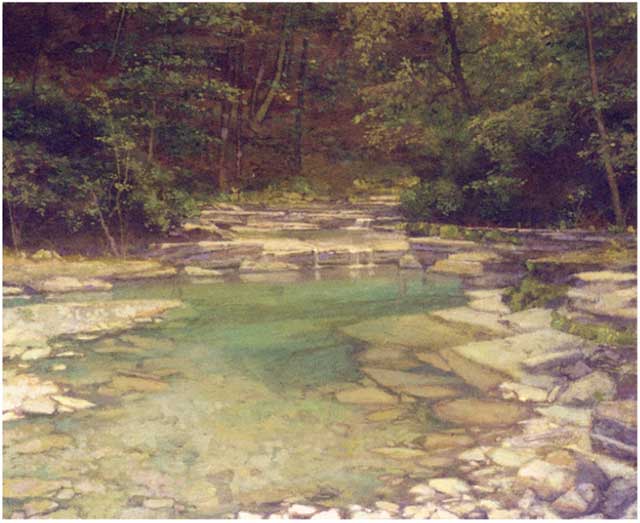 Landscape, Oil on Canvas, 18” x 22”, 2000 Innes Collection, Charlottesville, VA
Landscape, Oil on Canvas, 18” x 22”, 2000 Innes Collection, Charlottesville, VA
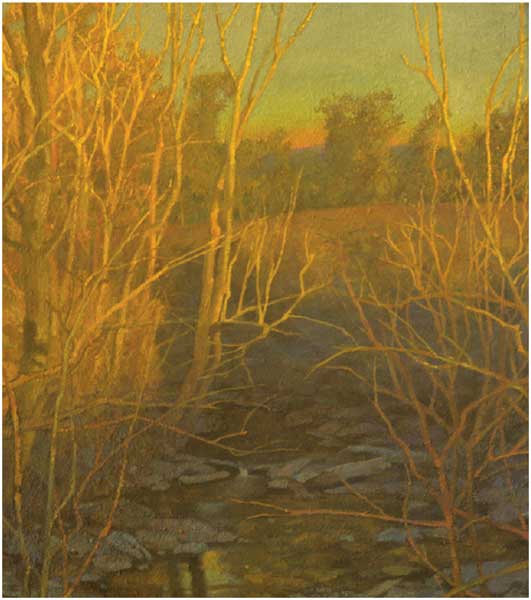
Landscape, Oil on Canvas, 18” x 22”, 1989 Collection: Hobart and Wm. Smith College, Geneva, NY
EH: Is painting a meditative activity for you?
My current understanding is that meditation is a technique that can help move us past our constructed sense of ego (the fear-based self) into our true nature which is essentially love. If it is understood this way, then painting can certainly be seen as a kind of meditation.
For instance, I may appear to be handling life and look like I have my act together but in truth, inwardly, it is often the case that I am struggling with the stress of feeling that I will disappoint myself or that I will not fulfill my expectations or what I imagine are the expectations of others. At the root of all this is the fear of rejection and the bitter sense of being separate. Call it the survival instinct; it is the nagging inner voice that continually worries about how I am going to manage to get along in the world.
I go into the studio with these feelings often floating around in my head but then I finally notice some object or other in one of the still life set ups and it looks strange or interesting or captivating. Then I am pulled into painting by my feeling of curiosity and fascination with what I have seen. I experience the phenomenon that I have tried to describe in my book; a kind of self-forgetfulness as my attention narrows down to the canvas and the experience of looking at the still-life and the awareness of my hand with the brush in it, moving back and forth. I don’t know if I could call it love, it is more like a deep sense of connectedness with everything. After a couple of hours or whenever it comes to a conclusion, I always have a feeling of renewal which seems similar to what people have told me they experience in meditation.
Everyone has some way, or many ways which release them from fear – very often through the loving relationships in their lives. I also have many ways but I am grateful that I also have the experience in the studio where my fear of being separate just gets dissolved by my engagement with painting.
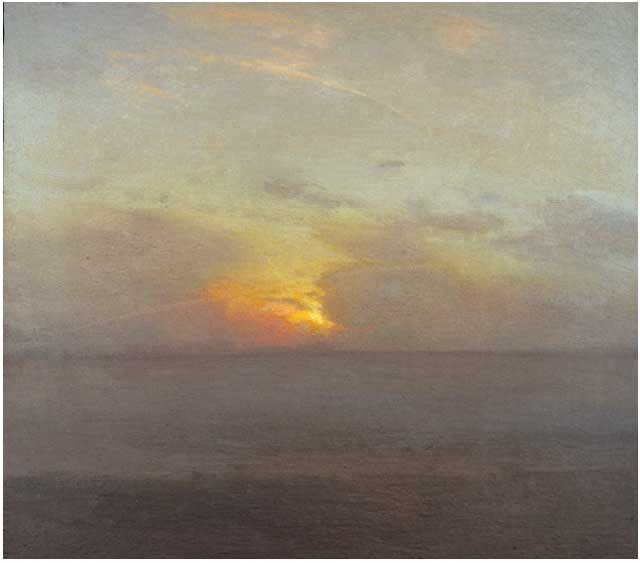
Seascape, Oil on Canvas, 16” x 18”, 1983 Collection: David Benn, Stevenson, MD
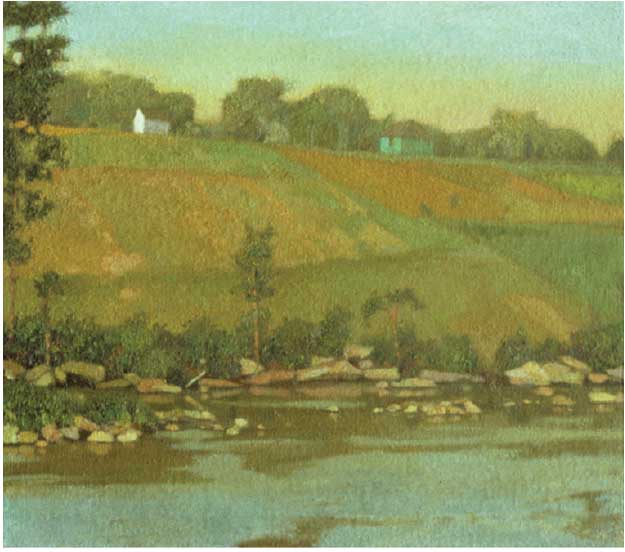
Landscape, Oil on Canvas, 16” x 18”, 1990
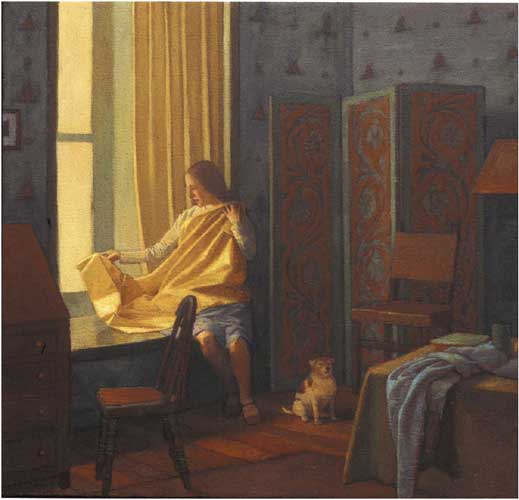
Woman with a Piece of Yellow Silk, Oil on Canvas, 20” x 21”, 1998, Private Collection
Statue of Persephone, 12.25” x 13.75”, 2002
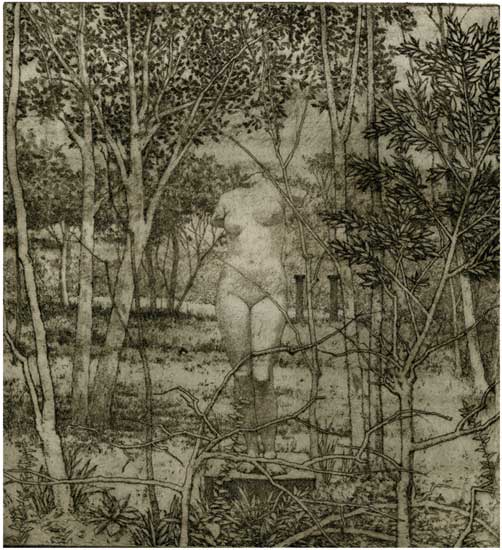
Landscape, 11.25” x 12.25”, 2001
EH: Could you expand upon the idea of narrative in your paintings?
GPK: For me, the notion of the narrative just refers to content in general, my narrative is the way I answer the question “what shall I paint?” This is not really as straightforward a question as it seems, though, it has many layers. On one level, it is the name of an object: an apple, a figure, an interior. But I also have to have a feeling sense about what kind of reality I want to see: the reality of sense experience? Dream reality? A somewhat stylized or abstracted reality? And of course these are not questions that I can answer with words; they are all issues that only get resolved through working in the studio. And like everything else about painting, it seems to change and grow over time as I also evolve.
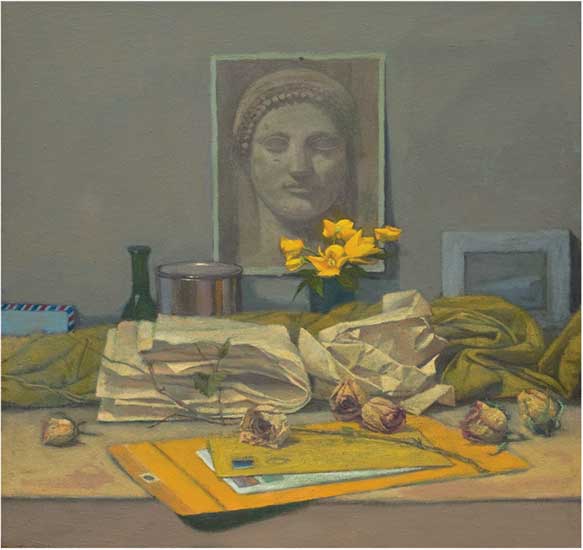
Still Life, Oil on Canvas, 18” x 19”, 2005, Private Collection
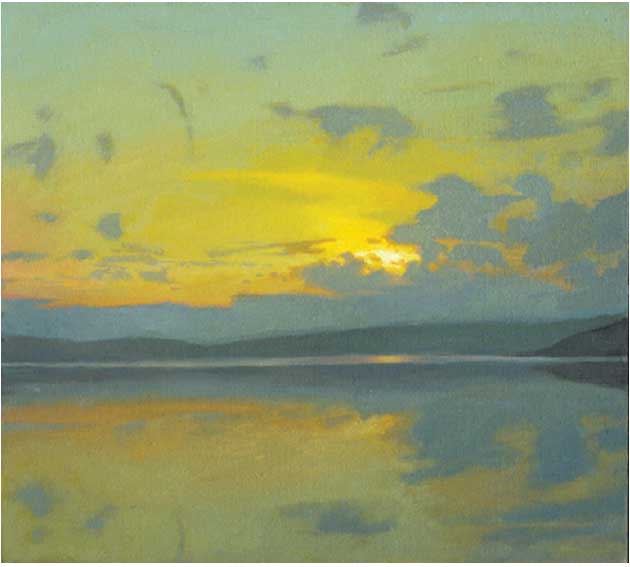
Seascape, Oil on Canvas, 16” x 18”, 1993, Private Collection
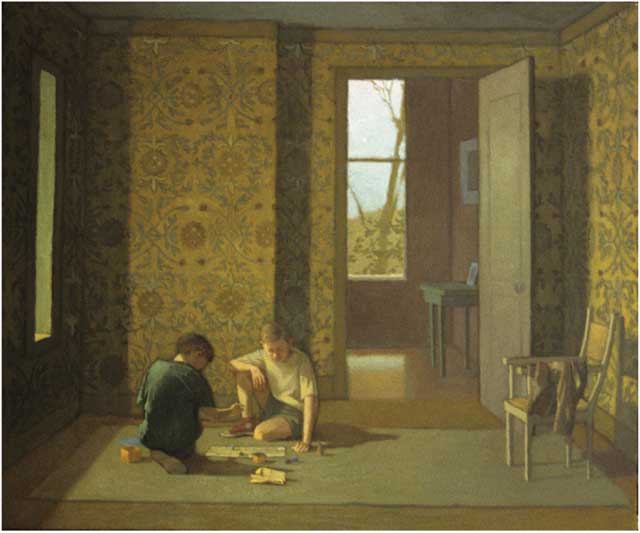
Monopoly, Oil on Canvas, 21” x 24”, 1998, Private Collection
EH: What advice do you have for young painters?
GPK: I don’t really have any advice for anyone else. When I put the book together – which is a collection of the ideas about painting that have been the most useful to me over the years, I did it not so much to offer advice as to offer myself as a companion. I had the idea that others who are like minded and traveling on their own might come across it and benefit from feeling reassured that their emerging point of view was shared and reinforced by someone else. It seemed the best way to respond to the fact that I have found friends and kindred spirits hidden in books in the past and discovering that they are out there has been enormously helpful.
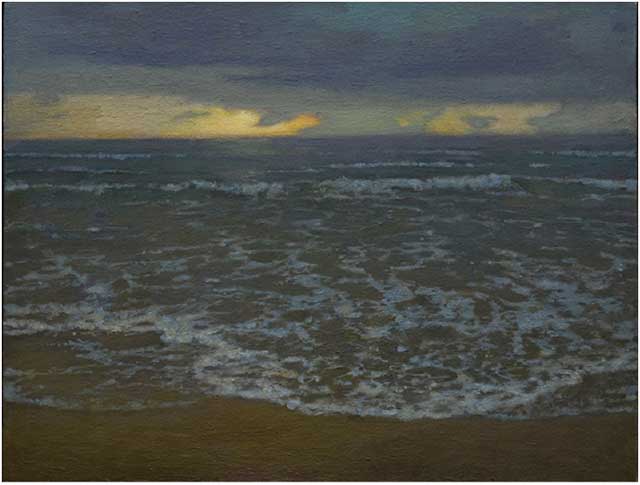
Seascape, Oil on Canvas, 16” x 21”, 2010
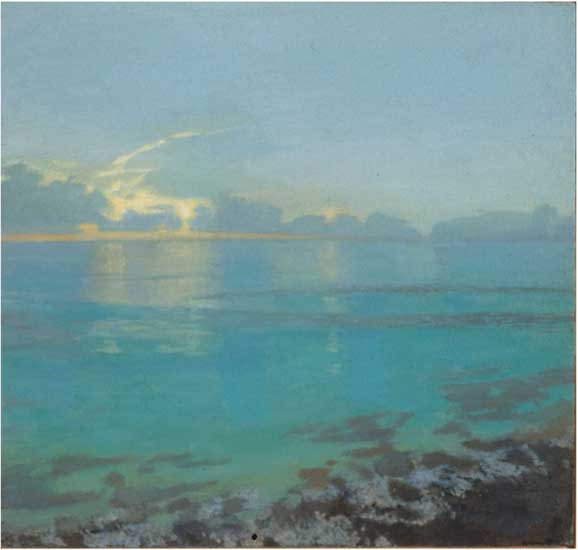
Seascape, Oil on Canvas, 17” x 16”, 1999, Private Collection
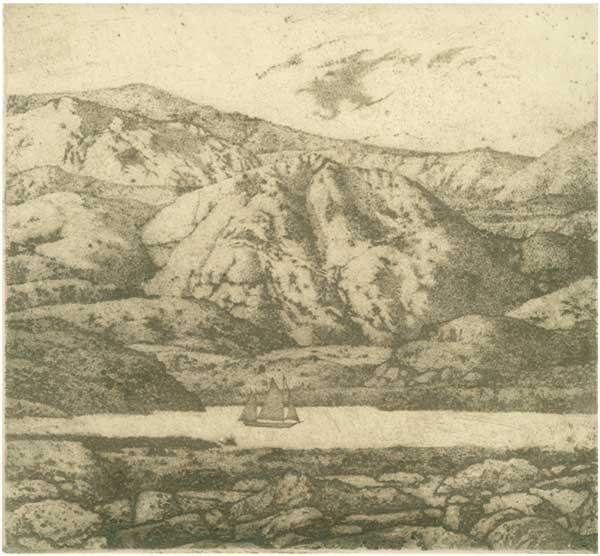
Landscape, 9.5” x 10.25”, 1981
Video of Gillian Pederson-Krag’s artist’s talk at a book reception
Gillian Pederson-Krag Book Reception Talk from Mark Scorelle on Vimeo.
Gillian Pederson-Krag Link to Gross McCleaf Gallery
Artist Profile in Outdoor Painter Magazine
Link more information and to order her Gillian Pederson-Krag Paintings and Etchings 1970-2011, published in 2012
Gillian Pederson-Krag grew up in N.Y.C. and went to the Rhode Island School of Design where she received a B.F.A. in 1961. In 1963 she received an M.F.A. from Cornell University where she later taught painting and drawing from 1966 to 1979. As a visiting critic, she has been to the Pennsylvania Academy of Fine Arts, Indiana University, Boston University, Maryland Institute College of Art among other schools. She has had several one person shows at the Hackett-Freedman Gallery in San Francisco, as well as the Johnson Museum in Ithaca, N.Y., The Hood Museum, Hanover, N.H., and the Southern Vermont Arts Center. Her work is represented in the permanent collections of the M.H.de Young Museum, San Francisco, the Clark Institute, Williamstown, Mass., the Memorial Art Gallery, Rochester, N.Y.., the Heckscher Museum, Huntington, N.Y., the Library of Congress Print Collection and the N.Y. Public Library Print Collection.

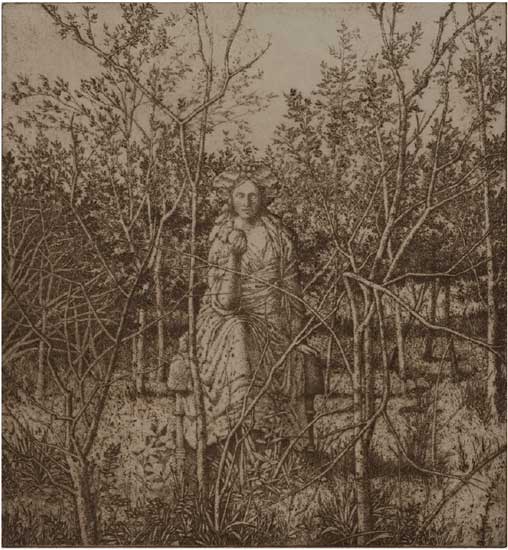
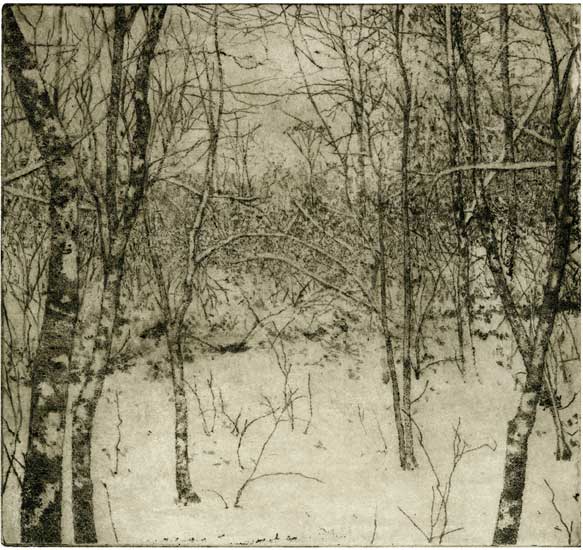




Dear Ms. Pederson-Krag,
I had the good fortune of seeing your paintings at the Winfield Gallery in Carmel,CA last October and have to say thank you for such beautiful work. If I had the money I would have bought them all! You are an inspiration.
Thank You,
Noel Robbins
Her paintings look like they are a wonderful mixture of subtle, blurred watercolour and sharp detailed line. It’s really interesting finding out more about how she perceives the world and that cross-over between imagined and actual reality.
My thanks to Ms Hagler for the excellent interview, and for presenting Ms Pederson-Krag’s beautiful, haunting work. I’m not slinging encomiums, I mean it. It is reassuring and inspiring to see such personal, original painting and etching spring from such “ordinary” subjects.
Thank you for letting us in and sharing with us the connections you perceive between your art and your perceptions of self. It is fulfilling to seek out the well-springs of what and why we paint. Thank you for wanting to share with kindred spirits. Your palettes and compositions are varied and beautiful. They speak out: “Study me, for you will learn much.” Your students are fortunate.
Gillian,
How wonderful that you have published your new monograph with the essays included too. The interview helps to reveal the motives you have as you paint, and develop your imagery.
Your book is a special book for me, and a special addition to my art library.
Bill
Very beautiful work. I am really impressed! Thanks for posting this interview Stan.
In my comment yesterday thanking you for posting this interview I suffered temporary brain freeze and called you Stan. Now unfrozen, my brain reminded me Larry much prefers to be called Larry. So “thanks, Larry.” Who’s that Stan guy anyway?
Hey Philip,Thanks for the comment and I’m glad you like this work as much as I do. I didn’t say anything before as Elana was the person who did such a good job with this interview, just so it’s clear where the credit should really go. Although I’m sure there is a Stan somewhere who deserves credit for something! Hope your holidays go well.
How can I get in touch with Gillia? I knew her in 1970 and never forgot our dialogue. Please help me connect again
try the link at the beginning of the article for her new book – it connects to her email when you click on it…
Just picked up Gillian’s book. Gillian Pederson-Krag Paintings and Etchings 1970-2011, published in 2012
A treasure!
thank you for this interview. I am looking forward to reading your book. Your thoughts give me hope and encouragement as a painter. I love your paintings and look forward to finding them locally in the near future,
warmly,
Hi Gillian, so glad to have found you again. (Cornell MFA 71-73). You came to mind while I was working in my studio, memories of long conversations. I just had to google you! Hope you are well.
Gillian, I was a student of yours at Cornell in ’74. It did some paintings out of class that you liked a great deal but determined at the time I should be a chemist or an engineer. Well long short is I became a kinetic sculptor and you will soon be seeing my work in all the usual places. I would very much enjoy communicating more privately if you’re up for it. You said some of the most profound things my ears have been graced to hear in 61 years of life, even though I bet that is not music to your ears. Anthony Howe
Hello Gillian. I, too, was a student of yours in the mid-seventies. I liked your work then, I love it more now. I’ve started to paint again after a long hiatus due to working in international public health. I would love to be in touch. You were a person who took notice of me when I needed it. I will try to reach you. Pamela Pine
Dear Gillian,
I’ve loved your work since first seeing it in the late 1960s. It made subjects that ordinarily look loud or chaotic, calm and reflective. It still reminds me of Masaccio and Watteau.
I was a student of yours in 1967-8, and loved you as a teacher. That training made me see things differently, and also made me think I actually could paint! I’m still painting… thank you!
Dear Gillian, I would like to purchase your book and the catalogs you have on your website, http://www.gillianpedersonkrag.com. email: pedersonkrag@yahoo.com. I received my BFA in 1979 from Cornell University. I attended and labored in quite a few of your painting classes, and I am most thankful for your approach of teaching which was characterized by kindness and flexibility. You allowed students to arrive at their own insights. This growth is a lifelong process which is gained by experience and work alone. There is no substitute for either one. You were most instrumental in providing a nurturing atmosphere conducive to success in the ongoing endeavor of simply being a good human being, and being true to the human soul and spirit within as an artist. This of course was something I caught from you, and went beyond what was taught in the hours of drawing and painting nudes and still life. I consider it a privilege to have had you as a professor at Cornell University. With Warmest Regards, George Ramos, Human Being, Artist
Hello Gillian,
The painting you did of me in 1967 hangs in my apartment in Paris, where I have lived since 2002. It brings back so many memories. I hope you are well, and are enjoying California.
Best, Emily Keast Donahue